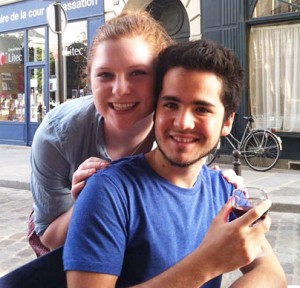Dance is Alive and Well and Living in Detroit

Four dancers from Epiphany Dance perform in Harmonie Park during DDCF.
“If you’re going to do a triple, it’s got to be fast.” The spacious stage of the Detroit Music Hall stage looked skeletal as thirteen young women learned a complex piece of jazz choreography. Well, thirteen young women and one virtuosic young man, no more than eleven years old, whose pirouettes were right on par with the rest of the class. The sounds of Cher and Chaka Khan echoed off of the art deco ceiling of the theater before sinking into the rich red velvet of the seats. Dancers pulsated with energy, hitting each beat meticulously for just a moment before leaping into the next one.
My weekend at Detroit Dance City Festival was full of moments like that. The Festival, in its third year during Summer 2015, is the brainchild of ARTLAB J founder and dance innovator Joori Jung. Originally from Seoul, Korea, she moved to Detroit and, in two short years, took it upon herself to make Detroit more open to the international dance community. The weekend of the Detroit Dance City Festival was a conglomerate of art makers, performers, and the business-minded people making dance a sustainable practice. Some attendees did all three.
Mind you, I was very much a fly on the wall here. I Irish-danced as a girl, but I had hung up the hard shoes a while ago and was perfectly content with observing this perfectly postured world as it spun around me. Workshops like the one in the Music Hall were happening every day and ranged in focus from jazz to modern to West African. I watched many of them, but my personal favorite was taught by Beatrice Capote, a dancer in Camille A. Brown and Dancers company. Once the class began, the West African drum beat hardly ever stopped. Beatrice built small gesture upon gesture, introducing this unique style of dance to a large group of students foreign to the form, until the room was full of stomping feet and flailing arms, all somehow keeping time to the impossibly quick rhythm. One of the most important elements of this style, Beatrice stressed, was connection. West African dance is a form of communication, a way to celebrate the extraordinary elements of the ordinary day. Certainly this was true of the workshop. What began as a group of serious, focused young artists melted into a crowd of smiling young people, improvising, applauding, and laughing.
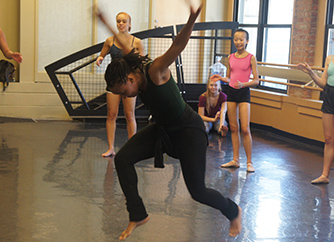
Beatrice Capote leads an improv session during her workshop.
That evening, Beatrice would perform a portion of Black Girl — A Linguistic Play with her fellow company members from Camille A. Brown and Dancers at the DDCF Gala, the cornerstone of the weekend. To begin the conversation on some of the elements of this work, she asked her workshop participants what they thought about when they heard the words “black girl.” There was an awkward silence, and I admit I was glad I didn’t have to come up with a response; there is no right answer to that question, but there are definitely wrong ones, and everyone treaded carefully with choice of words. Beatrice had obviously asked this question before and was familiar with this reaction. In fact, she said that it was this tension surrounding the concept of “black girl” identity that prompted Camille A. Brown and her dancers to create this work. Using what Beatrice referred to as “vernacular dance,” the company has referenced playground interactions, sibling bickering, handshakes, and pop culture (if you look closely you can spot Beyoncé’s infamous Single Ladies chug) to elevate the experience of young black women. The performance was moving, and the piece in its final state, coming to UMS in February, will not be one to miss.
The weekend was full of performances. I spent my late afternoons in the charming Harmonie Park across from the bustling Carr Center watching local dance troupes perform in beautiful sunshine. One group of four young girls from Epiphany Dance, a Detroit-based company, stood out in particular. Clad in bright yellows and greens, they glided across the stage in beautifully executed choreography. As I watched I couldn’t help but connect their passion with what is at the heart of Camille A. Brown’s work; these girls, sharing what they love without reserve or restraint, seemed to me to encompass what Camille might seek to capture in her art. Many of these outdoor performances felt just as joyful. I loved the way the brief season of Michigan warmth was animated through hip-hop, lyrical, rhythmic gymnastics, even Polynesian dance.
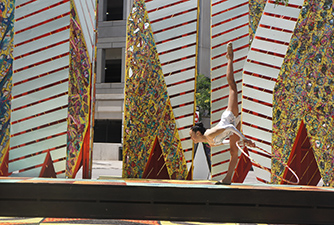
An exciting rhythmic gymnastic performance in Harmonie Park.
In the evenings, the art makers shined at the Choreographer Showcases. The first two nights of the Festival featured over twenty pieces from choreographers from across the country. I, like many, am a bit of a novice to the current trends in dance, and was pleasantly surprised to discover that dance is capable of much more than I initially assumed. I learned that, contrary to popular belief, dance does not need music. I saw multiple pieces in partial or total silence, pieces that kept me completely engaged. Dance can also use video, voice, and live music to elevate movement. One of my favorites used traditional mime techniques melded to modern hip hop to create a metaphor for immigrating to the states. I was mesmerized. As one participant told me, “The modern movement blew open the possibilities of dance, and we’ve been trying to figure out to do with it ever since.”
While performance was certainly the focus of the Festival, the weekend had an undercurrent of stimulating conversations about sustaining dance in Detroit and strengthening the international dance community. Through a series of panel discussions, I learned about the numerous organizations in Southeast Michigan who are dedicated to helping dance and those who create it thrive. Shivangee Pandya represented Creative Many, a group that advocates for the development of professional artists in Michigan. They provide legal aid, educate on the fundamentals of becoming a non-profit, and assist in contract work. They recognize that being a professional artist means running a business, and their dedication to the establishment of solid foundations for these artists shows a profound respect the dignity of creative work. I had the chance to chat with Lynne Friman of Culturesource and IXITI, a website that posts any and all creative performances and events happening in and around Detroit. With a shock of purple and blue hair and a big smile, she was able to list at least three people in the Detroit arts scene that you must know, all within the first five minutes of my chatting with her. She, and many others in attendance, are living advocates for the growing number of dance, theater, and music artists in the area, and they’re dying to tell you about it.
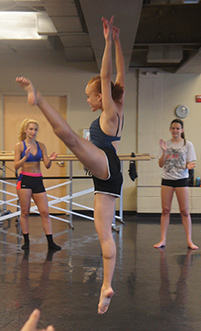
A dancer leaps during Beatrice’s workshop.
Equal parts celebration and exploration, the Detroit Dance City Festival never shied away from asking what dance is capable of. It wondered if it needed music, how it could be filmed, what props it could use, and who had access to it. The result was a real sense of community, a group of people who are willing to decide where dance can go from here. They will create the work, fund it, and find the audience, and they’ll enjoy the process just as much as the final product. It was exciting to be in on the secret that Detroit is rising fast on the global dance scale. Something tells me it won’t stay a secret for long.
Student Spotlight: Could You Repeat That? and Other Stories from Paris
Editor’s Note: Clare Brennan is a junior at the University of Michigan. This past summer she interned for ANRAT, a theater research company in Paris co-founded by Emmanuel Demarcy-Mota, director at Théàtre de la Ville. Their production of Pirandello’s Six Characters in Search of an Author comes to UMS October 24th and 25th.
The summer of 2014 consisted mainly of getting lost. As a first-timer to the grand city of Paris, or to any sort of international travel for that matter, I had incessantly practiced the correct way to ask for directions to the bus stop during my entire eight hour flight. Before I could get a “Bonjour” in edgewise, a bored flight attendant directed me towards my destination in perfect English, and I was on my way.
I’d gladly forget my first trek from the airport to the dorms, dragging my two oversized suitcases across town, but after the jetlag wore off, I started to get the hang of things. I became a lover of maps, discovering the metro system as quickly as possible. That knowledge invariably went out the window as soon as summer construction began. Eventually, I started ending up in the same places, and what was once a completely strange conglomerate of streets started feeling a little more like home.
Once settled in, I dove into the incredible wealth of theater surrounding me. With over 150 professional theaters within its city limits, Paris never let quantity deteriorate quality. One of my first shows was Ionesco’s Rhinocéros at Théàtre de la Ville. I had missed the production when it came to UMS last season, and was so excited when fellow UMS intern Flores Komatsu offered up a ticket to join him. We met at the theater and crossed one of the many bridges that connect the vastly different banks of the river to find a small café for dinner. A group of men of various ages played pétanque, the French equivalent of bocci ball, on a dirt patch next to us, a common pastime on summer evenings. Obviously American, we prattled away, catching up on upcoming projects, book recommendations, and travel plans. Eventually, the couple from Colorado sitting next to us struck up a conversation, and after twenty minutes we had learned the story of their ex-pat daughter and swapped recipes for favorite dishes we’ve discovered. Caught up in conversation, we barely realized we were running dangerously close to curtain time. We sprinted back to the theater and found our seats with just enough time to absorb the atmosphere.
*
I love theaters. Between their velvet curtains and cushioned seats, both actor and audience member gain some security to suspend their disbelief for a while and hear a story. I appreciate that sense of trust that seems built into the walls, and I always try and find it again before every show I see.
At Théàtre de la Ville, the most striking quality I found was its size, housing around 1,500. Our Monday evening show was sold out, and as I looked around, I noticed that most of those in attendance were around my age. In my exploration of the arts at home, I’ve often found truly invested younger patrons more difficult to find. There, young people come to shows, stay for talkbacks, and attend season premieres; Théàtre de la Ville’s season announcement, for instance, packed the house just as tightly as their best-known runs.
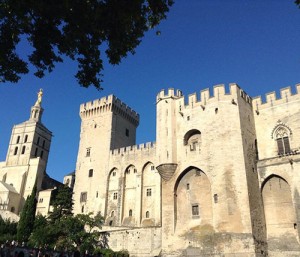
Photo: Le Palais de Pape, where “I Am” played during the Avignon Theater Festival in July. Photo by Clare Brennan
The house lights dimmed, and I experienced again what would quickly become one of my favorite culture moments abroad. Before an actor ever sets foot on stage, a score of audience members will audibly shush one another. It will be hard to forget my first experience of this sort, as the majority of hisses were directed at me. Foreign air and a lack of sleep had left me sick for a couple weeks, and, apparently, I thought that the start of the Moroccan acrobatic performance Azimut at Théàtre du Rond Point would be a lovely time for a coughing fit; the surrounding patrons did not. I quickly picked up this less-than-subtle social cue, and by the end of my two months, I was joining in as passive-aggressively as possible. Strong reactions like this were never out of place. At the Avignon Theater Festival, a production of Lemi Ponifasio’s I Am, a World War II homage in dance, produced critical laughter, side comments, even a small exodus after a particularly difficult movement. However, with this piece included, I also never saw a performance without at least five minutes of applause at the close.
*
Seeing theater in a foreign language took a bit of adjustment. Rhinocéros opens with a beautiful monologue. I couldn’t tell you what the first few lines mean now, as I was still looking for surtitles within the first few moments before I remembered where I was. I did have opportunities to try reading French surtitles during a Dutch production of Ayn Rand’s The Fountainhead and a Japanese kabuki style of the Mahabharata. Reading and translating French while listening to another language with which I had no experience left my American brain a little withered, but it did help me to abandon any pretenses I had when I arrived and dedicate a couple of hours to a completely new experience. Or four and a half hours, in the case of the Dutch Fountainhead. (I have to admit, I dozed off for about twenty minutes of that. I read the book in high school, so that counts, right?)
That night, Flores and I left the theater and lingered on the rainy sidewalk with a crowd of theatergoers doing the same. We all shared our thoughts, compared interpretations, raved over actors, and tried to weave our way through the denser moments. We said our goodbyes for the night, and as I turned to leave, I realized that I was pretty disoriented. I was lost in Paris again, but what else was new. Theater abroad left me dizzy and buzzing, not quite sure of where I stood but happy that I was there. I was used to the feeling by now, and there could be worse places to get turned around. Paris is a city for wandering, anyway.
A [brief] UMS History Presentation: The Guitar
As we get ready to welcome the Los Angeles Guitar Quartet to the Michigan Theater on April 10, 2014, we’re taking a look back to see just how far the guitar has come.
Putting On “The Suit”
Editor’s note: Student volunteers at UMS often get the chance to take a deep dive into a performance or art form. In this essay, UMS Marketing intern Clare Brennan reflects on her experiences with “The Suit” directed by the legendary stage and film director Peter Brook. The performance will be at Ann Arbor’s Power Center on February 19-22, 2014.
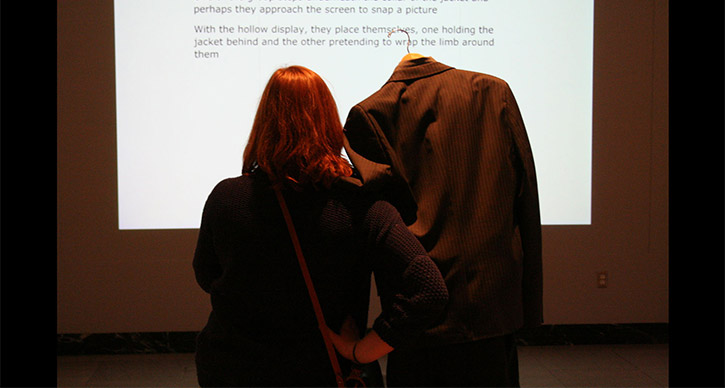
Photo: Clare Brennan and the UMS Student Committee take the suit around town as part of U-M Museum of Art’s “Love Art More” project. Photo by UMS Student Committee.
It’s not hard for me to remember one of the first books that really moved me. I was sitting in my living room, home alone on a bright August afternoon, finishing up some reading I’d been assigned for my last year of English in high school. I read the final paragraph, closed the back cover, and sat quietly for a while. I might’ve teared up a bit, if I’m being honest. The book was Alan Paton’s Cry, The Beloved Country, and it was then that I became infatuated with the stories and storytellers from South Africa.
As it turns out, my love for the French language and culture was growing right alongside this, as well as an absolute obsession with all things regarding Anglo-Saxon theater. Imagine, then, my elation when an opportunity to dive head first into The Suit fell into my lap. My nerdy heart fluttered. I accepted as nonchalantly as I could.
Apparently, my fixation with The Suit is not uncommon. Legendary theatrical director Peter Brook loved this story so much that, after directing the story once in French in 1999, he chose to return to it, this time in English. I had the chance to sit down with Michael Kondziolka, the Director of Programming here at UMS. He saw the debut of this production of The Suit last year in New York, and knew that Ann Arbor had to have the chance to see it. “It’s so painterly. A supreme colorist can use shadow and light and color and understands exactly how to use these different media to create a masterpiece. That’s what Peter Brook is doing. He knows how to use actors and written text and music and light and staging and movement and the audience, and how to craft all of that into something that is really powerful, really masterful.”
Of course, any discussion of South Africa must mention the recent passing of Nelson Mandela. The Suit is set on the cusp of Mandela’s most prominent years, and this energy of anticipation of what’s to come silently fills the stage. It provides an opportunity to see a South Africa without Mandela and his work, and as the world reflects on his incredible dedication to his country, taking a moment to step back and hear from those who came before him feels even more powerful.
With that context, The Suit might seem like a eulogy. Far from it. In talking with Michael, I got the chance to hear about what makes a Peter Brook piece tick. At the heart of each of his works is a dedication to simplicity. “This piece has a real lightness to it. And the lightness comes from the performance.” Over almost half- century of work, Brook has pared down his stages, from the intricate scenery of his staging of the Bard for the Royal Shakespeare Company to the openness of The Suit’s space. “It creates a sense of the fun of the performance. So you’ve got this really interesting visual experience. Your imagination is unlocked as an audience member, and that’s really entertaining and satisfying.” Brook trusts his audience, an honor not frequently given, and we’re free to reap the benefits.
While we covered many topics, my chat with Michael really focused on the music embedded in the show. From Schubert on the accordion to a poignantly placed introduction of Bach’s St. Matthew’s Passion (what Michael reverently referred to as “The Sistine Chapel of classical music”), it is evident that Brook knows exactly how to carefully weave music into his work. “Peter Brook is not only a master theater maker but he clearly is a student of culture, and the way in which he understands the meaning of these specific pieces of music and uses them to get his theatrical idea across.”
Studying up for The Suit has been a joy. Peter Brook knows how to tell a story, and his ability to transcend the barriers of the stage and approach each member of the audience with this incredible story of love and loss has no comparison. I’m so looking forward to seeing this show and finding what discoveries I still have left to make. The stage has a magical quality, and, in The Suit, it’s clear that Peter Brook knows it. “It’s pure poetry,” as Michael eloquently sums up. From what I can tell, I think he’s on to something .
Interested in learning more? Check out a brief infographic history of Peter Brook’s career or watch a storybook introduction to the performance.
Sources:
http://www.bouffesdunord.com/en/about-us/peter-brook
http://frenchculture.org/visual-and-performing-arts/events/us-premiere-suit-directed-peter-brook
A [brief] UMS History Presentation: Peter Brook
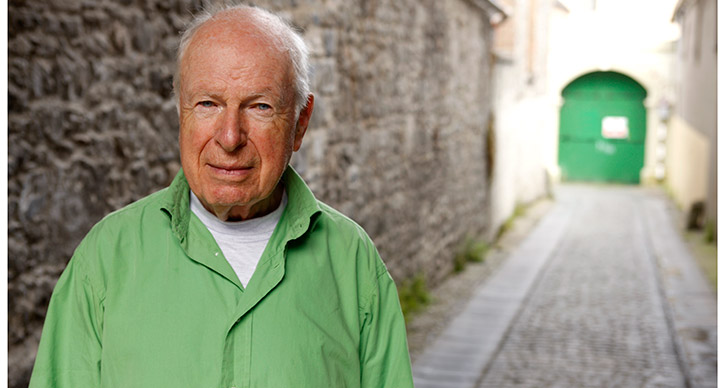
Photo: Peter Brook. Photo by Colm Hogan.
Director Peter Brook’s contributions to theater have spanned stage, film, and literary worlds. He directs The suit, performed by Théâtre des Bouffes du Nord at the Power Center in Ann Arbor February 19-22, 2014.
His legendary career has spanned decades and the world. Explore the timeline in this infographic:


